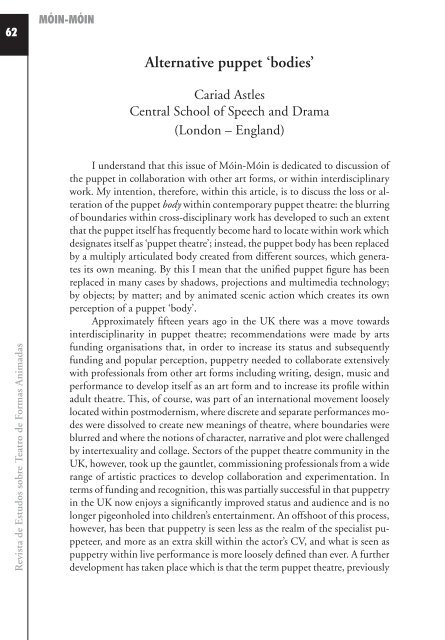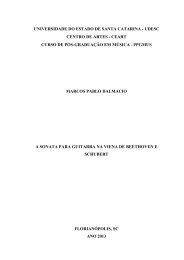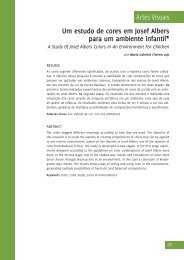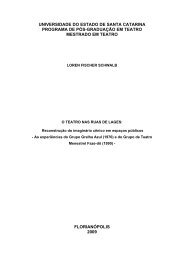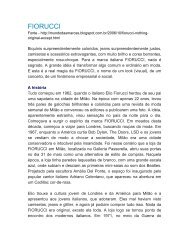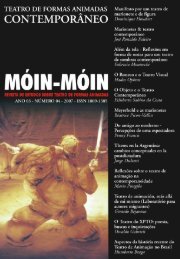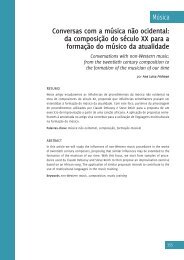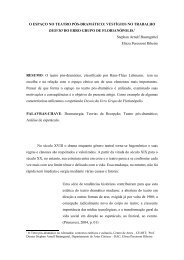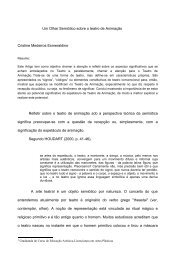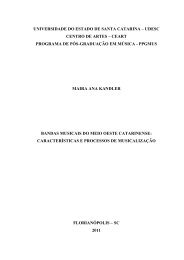Edição e distribuição www.designeditora.com.br Tipologia Adobe ...
Edição e distribuição www.designeditora.com.br Tipologia Adobe ...
Edição e distribuição www.designeditora.com.br Tipologia Adobe ...
Create successful ePaper yourself
Turn your PDF publications into a flip-book with our unique Google optimized e-Paper software.
62<<strong>br</strong> />
Revista de Estudos so<strong>br</strong>e Teatro de Formas Animadas<<strong>br</strong> />
MÓIN-MÓIN<<strong>br</strong> />
Alternative puppet ‘bodies’<<strong>br</strong> />
Cariad Astles<<strong>br</strong> />
Central School of Speech and Drama<<strong>br</strong> />
(London – England)<<strong>br</strong> />
I understand that this issue of Móin-Móin is dedicated to discussion of<<strong>br</strong> />
the puppet in collaboration with other art forms, or within interdisciplinary<<strong>br</strong> />
work. My intention, therefore, within this article, is to discuss the loss or alteration<<strong>br</strong> />
of the puppet body within contemporary puppet theatre: the blurring<<strong>br</strong> />
of boundaries within cross-disciplinary work has developed to such an extent<<strong>br</strong> />
that the puppet itself has frequently be<strong>com</strong>e hard to locate within work which<<strong>br</strong> />
designates itself as ‘puppet theatre’; instead, the puppet body has been replaced<<strong>br</strong> />
by a multiply articulated body created from different sources, which generates<<strong>br</strong> />
its own meaning. By this I mean that the unified puppet figure has been<<strong>br</strong> />
replaced in many cases by shadows, projections and multimedia technology;<<strong>br</strong> />
by objects; by matter; and by animated scenic action which creates its own<<strong>br</strong> />
perception of a puppet ‘body’.<<strong>br</strong> />
Approximately fifteen years ago in the U there was a move towards<<strong>br</strong> />
interdisciplinarity in puppet theatre; re<strong>com</strong>mendations were made by arts<<strong>br</strong> />
funding organisations that, in order to increase its status and subsequently<<strong>br</strong> />
funding and popular perception, puppetry needed to collaborate extensively<<strong>br</strong> />
with professionals from other art forms including writing, design, music and<<strong>br</strong> />
performance to develop itself as an art form and to increase its profile within<<strong>br</strong> />
adult theatre. This, of course, was part of an international movement loosely<<strong>br</strong> />
located within postmodernism, where discrete and separate performances modes<<strong>br</strong> />
were dissolved to create new meanings of theatre, where boundaries were<<strong>br</strong> />
blurred and where the notions of character, narrative and plot were challenged<<strong>br</strong> />
by intertexuality and collage. Sectors of the puppet theatre <strong>com</strong>munity in the<<strong>br</strong> />
U, however, took up the gauntlet, <strong>com</strong>missioning professionals from a wide<<strong>br</strong> />
range of artistic practices to develop collaboration and experimentation. In<<strong>br</strong> />
terms of funding and recognition, this was partially successful in that puppetry<<strong>br</strong> />
in the U now enjoys a significantly improved status and audience and is no<<strong>br</strong> />
longer pigeonholed into children’s entertainment. An offshoot of this process,<<strong>br</strong> />
however, has been that puppetry is seen less as the realm of the specialist puppeteer,<<strong>br</strong> />
and more as an extra skill within the actor’s CV, and what is seen as<<strong>br</strong> />
puppetry within live performance is more loosely defined than ever. A further<<strong>br</strong> />
development has taken place which is that the term puppet theatre, previously


